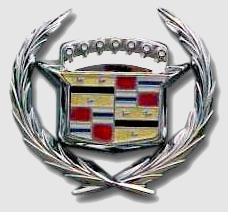The classic crest shown above was used from 1963. Before that it changed many times.
http://www.car-nection.com/yann/Dbas_txt/mascots.htm for pictures of Insignias, Mascots, Coat of Arms, etc
Ya ready for a long read? http://www.car-nection.com/yann/Dbas_txt/Coatarms.htm
About 5/8 down the page starts the crest info with a ton af pics!!!
The following descriptions are drawn from the merchandising booklets published a number of times between 1918 and 1960 by the former Cadillac Motor Car Company, subsequently the Cadillac Motor Car Division of General Motors Corporation. Again, the additional explanations and comments in blue, between square brackets, are mine. (the writer, not mine)
The Couronne or Coronet [above the crest] is that borne by the six ancient counts of France and is emblematic of descent from the old counts of Toulouse, who were affiliated with the royal French stock. The seven pearls in the couronne indicate the nobleman's descent from these royal counts [we know for sure that Antoine de Lamothe-Cadillac was born Antoine Laumet, the son of an assistant mgistrate at the local court and a modest home-maker].
The Shield: is significant of the heroic origin of the Cadillac arms. This is the form in which the coat of arms of the Cadillac family was first displayed by some ancient Holy Crusader [in-depth research in France, by Jean Boutonnet and Jean Cadilhac has uncovered no noble de Lamothe-Cadillac family in that country, nor any such coat of arms].
The First and Fourth Quarterings [the only authentic part of the de Lamothe-Cadillac coat of arms]. These quarterings are strictly the arms of the Mothe family [in fact de Lamothe, not la Mothe and - yes - these arms belong strictly to the de Lamothe estate at Bardigues, France]: Gold 9, a fess [bar], sable [black] between three merlettes of the same [i.e martlets or martins (birds) of the same color] posed two in chief [i.e. two of them placed above the black bar] and one in base [i.e. below the bar]. The birds or "merlettes", legless and without beaks, are a heraldic adaptation of the martin. Appearing in threes they have a holy significance, being considered sacred to the Trinity. They were granted to Knights by the ancient School of Heralds, together with the "fess" for valiant conduct in the Crusades. The birds shown in black against a gold background in this section [or "quartering"] of the Cadillac coat of arms denote wisdom [yes, there is no doubting that Laumet-Cadillac was one smart guy], riches [Cadillac did get rich, trading with the Indians around what became Detroit], and cleverness of mind [yes, indeed!], ideal qualities for the adventurous and zealous Christian Knight [and for an equally zealous and adventurous, Antoine Laumet!]
Of the merlette, Guillaume, an ancient historian, says: "This bird is given for a difference, to younger brothers to put them in mind that in order to raise themselves they are to look to the wings of virtue and merit, and not to the legs, having but little land to set their feet on" [the Laumet family, it is known, were not landed gentry]10. Of the "fess", he says: "This is a military girdle of honor," and signifies that the bearer "must always be in readiness to undergo the business of the public weal" [i.e to work for the general wellbeing of the people - Laumet appears to have been working mainly for his own wellbeing].
The Second and Third Quarterings [sometimes described as the "flags"] were probably adopted [the writer is admitting he doesn't really know, for sure] by some fortunate intermarriage in time long ago, another "Seigneurie" [a domain or large tract of land] was added to their possessions. In these quarters the colors used denote that the marriage added to the fame of the family de la Mothe [de Lamothe], something besides broad acres - "marked prowess and boldness in action" for the red; "purity, charity, virtue and plenty" for the silver. The repetition of the cross bar or "fess" [the blue band on the silver base] indicates more knightly prowess in the far fields of the Crusades [in Laumet-Cadillac's case it probably indicated more "nightly prowess" in the bed of Guyon's 17-year-old niece... Nevertheless, according to the Report on Canadian Archives, Ottawa, 1911, these arms could be those of either Virès, in France's Languedoc region, or Albret in Gascony]
Apart from the purely heraldic aspect of a coat of arms is its historic aspect. Every crest is linked with a history in which is enfolded the origin, genealogy, deeds, services, honors and alliances of the family bearing it. In all France, there are few families more ancient than the Cadillacs [as previously stated, in-depth research into French genealogy has uncovered not a single, noble Cadillac family from which Laumet-Cadillac might be descended]. In both dignity of design and significance of detail, the Cadillac coat of arms speaks volumes in courage and honor for the forebears of the Father of Detroit."
can I get my cookie?





















